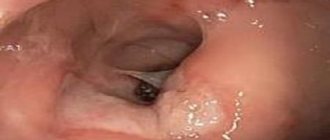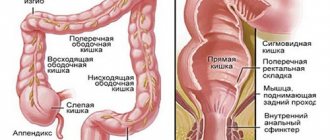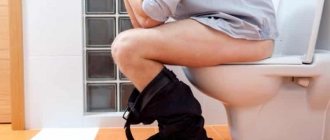Causes of paraproctitis
There can be several causes of rectal fistula:
- A small hole near the anus. An infection gets into it, this causes inflammation and as a result an abscess is formed.
- The formation of a fistula after paraproctitis occurs as a result of the fact that during the intervention the hole inside the intestine was not eliminated, as a result of which infection occurred when the abscess was opened.
- Also, one of the reasons for the appearance of a fistula may be: lack of personal hygiene, pelvic injuries, manipulations during which damage to the walls of the anus occurred.
- The causes may be some anorectal diseases: hemorrhoids, anal fissures.
- Often, a fistula occurs in people with various kinds of neurotic diseases, in patients with diabetes, and in people who abuse alcohol.
Clinical manifestations of rectal fistula
Typically, patients complain of the presence of a fistula (wound) on the skin in the anus. Due to the discharge of pus and ichor, the patient has to wear a pad and perform water procedures several times a day. The discharge can cause itching and irritation on the skin.
Symptoms of rectal fistula
Symptoms of rectal fistula may be as follows:
- Formation of a wound in the anal area;
- discharge of blood, ichor from the wound, unpleasant odor;
- soreness, redness and irritation of the skin;
- compactions with pus along the rectal fistula;
- unstable general condition of the patient: restless sleep, irritability;
- disturbances of urination and stool.
Fistula paraproctitis - classification
Fistula paraproctitis has its own characteristics; for this purpose, experts have created a classification:
- Intrasphincteric fistulas. The simplest type of illness. In this case, their course is somewhat slowed down, and the inflammation is mild.
- Transsphincteric fistulas. Quite a common species, found quite often. It is characterized by the fact that the passages are localized in the subcutaneous layers and have branching.
- Extrasphincteric fistulas. The most dangerous form of paraproctitis, which occurs in 20% of cases of rectal pathologies. The fistula is localized on the internal sphincter.
The greatest danger to human health are pathologies that have a wide internal exit, surrounded by purulent scars.
Types of rectal fistulas
Depending on the localization of the process, there are extrasphincteric, transsphincteric, intrasphincteric, rectovaginal fistulas of the rectum.
Intrasphincteric fistula (the fistula canal is located in the subcutaneous layer along the edges of the anus) is the simplest type of fistula, the initial stage of the disease, detected in 25-30% of cases. It has a direct course, the cicatricial process has not yet appeared.
A transsphyctic fistula passes partly through the sphincter, partly through the tissue. They make up more than 40% of the total number of identified fistulas. In the fistula tracts there are branches, purulent pockets, and scar processes develop in the surrounding tissues.
An extrasphyctic fistula is located deep in the skin layer, goes around the external sphincter of the rectum and opens on the skin of the perineum.
A rectovaginal fistula is formed between the lumens of the rectum and vagina.
Degree of complexity of rectal fistula
The mild degree is characterized by the presence of a direct fistula tract, the absence of cicatricial changes, infiltrates and pus.
Moderate degree: scar formation occurs near the internal opening of the fistula tract.
Moderate degree: a narrow opening is formed in the entrance fistula canal, there is no pus or infiltrates.
Severe degree , characterized by the appearance of multiple scars and the appearance of ulcers and infiltrates.
Symptoms
The symptoms of paraproctitis are not difficult to recognize; they are pronounced.
The main symptoms of fistulas:
- On the skin of the gluteal region, you can visually determine the opening of the fistula.
- From the external fistula opening and anus, minor discharge appears in the form of pus, blood, and feces.
- Near the external opening, the fistula tract can be easily palpated; it is defined as an elastic, dense cord.
- There are nagging pains in the area of the fistula and rectum, which greatly intensify during defecation, their intensity directly depends on the stage of the disease; When the disease worsens, the pain may become regular and be accompanied by a rise in temperature.
Diagnosis of fistula with paraproctitis
To diagnose the disease, a specialist prescribes a comprehensive examination, including: anamnesis, probing, instrumental and clinical examination, fistulography, ultrasound examination of the rectum, and a dye test.
1. During digital examination, the fistula tract, its branches and cavities are determined.
2. Ultrasound determines the localization of the fistula tract.
3. Probing can detect the presence of purulent cavities in the wounds, as well as the direction of the fistula tract.
4. Fistulography is an examination that allows you to determine the course and extent of the fistula.
5. A dye test is necessary to mark the internal passages of the fistula.
6. Computer MRI is necessary only in complex cases when other methods do not allow identifying complex fistula tracts.
Treatment and surgery to remove fistula paraproctitis
Various techniques are used to treat a fistula; they depend on the size of the fistula, its location and course relative to the sphincter and rectum. At the initial stages of the disease, effective therapeutic methods can be used: using a sealing tampon and filling the fistula with special fibrin glue. These interventions are not traumatic, but are not particularly effective, especially in severe cases. As a rule, experts recommend them as a primary method if radical intervention has a risk of complications.
If there is a possibility that an abscess can provoke an inflammatory process, antibiotics and physiotherapeutic procedures are used to prevent it. When the fistula openings have closed and a period of remission has begun, you need to stop taking medications and continue treatment of the fistula. If an abscess has already formed, it must be urgently removed, and then think about surgery.
Rectovaginal fistula - symptoms and treatment
Conservative treatment
This method of therapy includes: sanitation of the rectum and vagina, impact on the internal lining of the fistulous tract (curettage, chemical and thermal ablation), limiting the passage of intestinal contents. However, at present there are isolated cases of closure of rectovaginal fistulas during conservative treatment. The use of these methods is not justified from the point of view of evidence-based medicine and can only delay surgical intervention, thereby worsening its results.
Surgery
In modern medicine, the treatment of rectovaginal fistulas is included in the professional competence of a coloproctologist. It is very important that surgical treatment is carried out by qualified specialists in specialized centers, since otherwise the likelihood of relapse of the disease is very high.
The very existence of a rectovaginal fistula is an indication for surgical treatment.
Today, there are more than 100 different methods of surgical treatment of rectovaginal fistulas. The choice of a specific method of surgical treatment depends on the level of location of the fistula tract (high or low fistula), the complexity of the fistula (direction and nature of the fistula tract, the presence of additional branches, purulent cavities and leaks), as well as the condition of the obturator apparatus of the rectum.
The presence of purulent cavities and bruises requires a two-stage approach to treatment. In this case, at the first stage, opening, drainage and sanitation of purulent cavities are performed, and only after adequate drainage and elimination of purulent cavities do they proceed to the second stage - an operation directly aimed at eliminating the rectovaginal fistula.
The most widely used methods in the treatment of rectovaginal fistulas are:
1. Segmental proctoplasty or reduction of a full mucomuscular flap is one of the technically complex, but most radical methods for eliminating a fistula. The operation involves excision of the fistula to the fistula opening in the rectum. Then a full-fledged mucomuscular intestinal flap is mobilized and lowered, followed by its fixation so that the flap covers the location of the internal fistula opening in the intestine. Treatment of patients occurs in 60-95% of cases.
2. Excision of the fistula into the intestinal lumen . [38] The operation is possible only with low intra- and transsphincteric rectovaginal fistulas and involves excision of the fistula tract from the external to the internal fistula opening. Efficiency - 70-96.6% of observations.
3. Excision of the fistula with sphincteroplasty .[41] Performed for transphincteric and extrasphincteric fistulas and the presence of a sphincter defect along the anterior semicircle. The operation involves excision of the fistula into the intestinal lumen, then isolation and mobilization of the ends of the sphincter and their suturing. Successful cure occurs in 41-100% of cases.
4. Martius operation ( transposition of the bulbocavernosus muscle into the rectovaginal septum between sutured defects of the rectum and vagina). Options for surgery include moving a piece of adipose tissue on a vascular pedicle from the area of the labia majora or inguinal fold.[39][40] This operation is performed for high rectovaginal fistulas, as well as for post-radiation fistulas and Crohn's disease. The surgical technique consists of splitting the rectovaginal septum and excision of the fistula opening in the intestine and vagina. Defects in the walls of the vagina and rectum are sutured. The bulbocavernosus muscle on the vascular pedicle (a fragment of adipose tissue on the vascular pedicle from the area of the labia majora or inguinal fold) is isolated and transposed (moved) to the rectovaginal septum. Efficiency - 50-94% of observations.
5. Transposition of the tender muscle of the thigh into the rectovaginal septum between sutured defects of the rectum and vagina .[42][43] The indications for this type of surgical intervention are the same as for the Martius operation. Cure of patients occurs in 50-92% of cases.
The role of intestinal stoma in the treatment of rectovaginal fistulas
One of the key points associated with the successful treatment of rectovaginal fistulas is limiting the passage of intestinal contents, as an environment with a high content of bacteria, in the area of the operation. It is sometimes possible to provide protection against infection in case of recurrent, previously operated fistulas only by creating an intestinal stoma. The decision to form a stoma is decided strictly individually in each case. However, with high and complex rectovaginal fistulas, regardless of etiology, the formation of a preventive intestinal stoma can significantly reduce the risk of developing postoperative complications and improve treatment results.[1][2]
The stoma is closed when the surgical site heals, which occurs within 2-6 months.
Is it necessary to remove a fistula in case of paraproctitis?
Often, removal of the fistula is the only way to get rid of this pathology. The operation to remove a fistula for paraproctitis involves cutting or excision of the fistula tract.
Methods of surgical treatment of fistulas
- Excision of the fistula, closing its course using a rectal flap. This method is plastic surgery.
- Excision of the fistula into the intestinal cavity or its dissection.
- Dissection of the fistula and its ligation in the space between the internal and external sphincters.
- Resection of the fistula tract followed by suturing of the sphincter. This intervention also applies to plastic surgery, but it often leads to sphincter insufficiency.
- Resection of the fistula, application of a crossing or draining ligature (sling). Gradually, the crossing ligature is tightened, while cutting the fistula.
Despite highly effective methods, in some cases, after removal of paraproctitis, a fistula develops again. This is due to the incorrect choice of technique, a technical error during the operation, or improper healing of the fistula tract.
Paraproctitis and fistulas
If you have complaints of pain in the anus or rectum, which are accompanied by fever and chills, this may indicate the presence of paraproctitis (or perianal abscess) or rectal fistula (or perianal fistula).
What is paraproctitis?
Paraproctitis or perianal abscess is an infected cavity filled with pus and located next to the rectum or anus.
What is a rectal fistula?
Almost always, the cause of the development of a rectal fistula (or perianal fistula) is a previous perianal abscess. Inside the anus (anus) are small anal glands. When these glands become clogged, they can become infected and a perianal abscess occurs. A fistula is a passage that forms under the skin and connects the inflamed anal gland and the skin of the buttocks outside the anus.
What causes a perianal abscess?
A perianal abscess occurs as a result of acute infectious inflammation of the anal gland when bacteria or a foreign substance penetrates its tissue. With some diseases, such as colitis or other inflammatory bowel diseases, these infections may occur more frequently.
What causes rectal fistula?
After draining the perianal abscess, a passage may form between the skin and the anal gland, which caused paraproctitis. If pus continues to be discharged from the external opening of the fistula, this may indicate the functioning of the fistula. Even if the external opening of the fistula has healed on its own, this does not guarantee that paraproctitis will not reoccur.
What are the symptoms of paraproctitis and rectal fistula?
Manifestations of paraproctitis are pain, swelling and swelling in the anus. Weakness, fever and chills may also occur. Additional complaints characteristic of a fistula include irritation of the skin around the anus, discharge of pus (which is associated with relief of the patient’s condition), fever and general malaise.
Does rectal fistula always form with paraproctitis?
No not always. Rectal fistulas form in only half of patients with paraproctitis, and today there is no method that could reliably determine whether a fistula will occur or not.
What is the treatment for paraproctitis?
Treatment of paraproctitis involves making an incision in the skin near the anus to remove pus from the infected cavity and reduce the pressure inside it. Quite often this can be done on an outpatient basis using local anesthesia. Treatment of large or deep abscesses may require hospitalization in a specialized hospital that can provide adequate pain relief during surgery. Hospitalization is indicated for patients with a tendency to serious infectious complications (patients with diabetes mellitus and decreased immunity). Conservative (non-surgical) treatment with antibiotics alone is not as effective as drainage (removing pus). This is due to the fact that antibiotics cannot penetrate the abscess cavity and act on the purulent contents located there.
What is the treatment for rectal fistula?
Treatment of rectal fistula is only surgical. Despite the fact that many options for surgical treatment of rectal fistulas have been developed, the likelihood of complications remains quite high. Therefore, it is preferable for the operation to be performed by a coloproctologist (colorectal surgeon). Simultaneous treatment of fistula and paraproctitis is possible, although usually the fistula develops in the period from 4 to 6 weeks after drainage of the abscess, in some cases it can occur months and years later. The main principle of surgical treatment of rectal fistulas is the opening of the fistula tract. This is often accompanied by excision of a small portion of the anal sphincter, i.e. muscle that controls stool retention. Connecting the internal and external openings, opening the fistula tract and transforming it into an open state allows for rapid healing of the resulting wound in the direction from the bottom to the edges. Often, surgical treatment of rectal fistulas can be performed on an outpatient basis. However, treatment of deep or widespread fistulas may require hospitalization.
How long does the healing process take?
In the first week after surgical treatment of a fistula, the patient may experience moderate pain, which can be controlled with painkillers. The period of forced disability is minimal. After surgical treatment of a fistula or paraproctitis, a period of follow-up treatment at home is necessary using sitz baths 3-4 times a day. It is recommended to add dietary fiber or laxatives to the diet. To prevent contamination of underwear, you can use gauze bandages or pads. Normal stool has no effect on wound healing.
What are the chances of a fistula or abscess reoccurring?
Provided proper healing occurs, the risk of recurrence of the disease is minimal. However, it is necessary to follow the recommendations of a coloproctologist (colorectal surgeon).
Who is a colorectal surgeon (coloproctologist)?
Coloproctologist surgeons are highly qualified specialists in the surgical and non-surgical treatment of diseases of the colon and rectum. They have a certificate of completion in general surgery and specialized training in the treatment of diseases of the colon and rectum. Coloproctological surgeons can treat benign and malignant formations, examine patients and, if necessary, perform surgical treatment of diseases.
Diet
After surgery, the patient must follow a diet. For the first few years, he should eat low-calorie, bland food. The consumption of spicy, fried, too salty, smoked foods and foods high in carbohydrates is prohibited. This diet should be maintained until complete recovery.
The diet after removal of a rectal fistula includes drinking plenty of fluids (water). Carbonated and alcoholic drinks are strictly prohibited for this pathology.
A week after the operation, an expansion of the diet is allowed, but in any case, all food should be low-calorie and prepared in any way, excluding frying. It is not recommended to completely abandon the consumption of vegetable fats necessary for the body, since some groups of vitamins cannot be absorbed without them.
Treatment of rectal fistula
Don’t waste time; at the first symptoms of proctological diseases, consult a coloproctologist! This way you can avoid complications, the most dangerous of which is the malignant degeneration of chronic paraproctitis (fistula)!
The treatment regimen for rectal fistula is determined by a coloproctologist as a result of an examination, but today these are only surgical methods. They allow you to radically remove the entire fistula tract and cure the patient of rectal fistula once and for all. During the operation of excision of a rectal fistula, as a rule, concomitant diseases are removed - hemorrhoids, anal fissure, etc. Thus, treatment for a rectal fistula allows the patient to get rid of a whole list of unpleasant diseases in one fell swoop.
Wound care
Despite the fact that this care procedure is quite simple, caring for a postoperative wound must be thorough. Most often, rectal suppositories and dressings using ointments are prescribed to care for the area of excision of the fistula. In some cases, antibiotics may be used.
Regarding the dressings prescribed when removing a fistula, they are aimed not only at rapid healing of the wound, but also to protect it from infection. You can perform the dressing with the help of a specialist or yourself.
For this purpose, antibacterial, anti-inflammatory and wound-healing ointments are used. It is important to know that the ointment cannot be applied to the wound cavity left after removal of the fistula, since the outflow of fluid will be blocked.
Upon completion of defecation, the wound should always be treated with antiseptic agents or simply rinsed well. If bloody discharge is found on the bandage, this is normal when removing a fistula; to avoid infection, it must be urgently replaced.
You can care for the wound after removal of a rectal fistula using baths with healing solutions. Thus, it is recommended to use mumiyo, sea salt and medicinal plants. For a bath with mumiyo, you need to dilute the mumiyo convolute in 5 liters of water. Sea salt baths provide the following proportions: 2 tbsp. Dilute tablespoons of salt in 5 liters of water. Decoctions of medicinal plants are prepared in the following way: 2 tbsp. spoons of raw materials are diluted in 5 liters of water.
These agents have anti-inflammatory, antibacterial and immunostimulating effects on the skin in the postoperative period.
Preparing for fistula removal surgery
The operation to remove a rectal fistula is usually prescribed routinely. When chronic paraproctitis worsens, the abscess is usually opened urgently, and the fistula is removed after 1-2 weeks.
To diagnose the course of the fistula and determine the scope of the upcoming operation, the following is carried out:
sigmoidoscopySigmoidoscopy. The identification of the internal opening is carried out using paint (methylene blue mixed with hydrogen peroxide) injected into the external opening of the fistula.
- Fistulography is a radiopaque examination of the fistula.
- It is advisable to have an ultrasound or CT scan of the pelvic organs to examine the condition of neighboring organs.
Preparation for surgery is not much different from preparation for other surgical interventions: blood and urine tests, biochemical analysis, fluorography, ECG, and examinations by a therapist and gynecologist for women are prescribed.
If the patient has concomitant chronic diseases, it is necessary to correct their treatment to achieve compensation for basic body functions (heart failure, diabetes, arterial hypertension, respiratory function).
It is advisable to culture fistulous secretions (in the presence of pus) to identify the main pathogen and determine sensitivity to antibiotics.
In case of a low-grade inflammatory process, preliminary anti-inflammatory therapy is usually carried out - antibacterial drugs are prescribed based on culture results, as well as local therapy (washing the fistula) with antiseptic solutions.
Three days before surgery, a diet is prescribed with limited fiber and gas-causing foods (raw vegetables, fruits, sweets, brown bread, legumes, milk, carbonated drinks)
Cleansing the intestines on the eve of surgery is carried out using cleansing enemas (evening and morning) or taking laxatives. The hair in the perineal area is shaved off.
Contraindications for surgery:
- Severe general condition.
- Infectious diseases in the acute period.
- Decompensation of chronic diseases.
- Blood clotting disorder.
- Kidney and liver failure.
It is not recommended to perform an operation to remove a fistula during a period of persistent subsidence of the inflammatory process (when there is no discharge from the fistula). The fact is that at this time the internal opening may be closed by granulation tissue and it will not be possible to detect it.
The use of folk remedies
Has anyone cured paraproctitis fistula using folk remedies? This is a question that interests many who are faced with this problem. There is no definite answer to this, since proven folk methods are most often used as part of complex therapy.
Treatment with folk remedies for fistula after paraproctitis is carried out after the operation. For this purpose, enemas with various infusions of medicinal herbs are used. For this, the most common and accessible herbs are used: chamomile, sage, yarrow. It is worth noting that a medicinal enema can be performed only after a cleansing enema - this will significantly increase the effectiveness of the method.
Home treatment of paraproctitis with folk remedies will be effective only when combined with medical prescriptions. Herbal medicine is only a good auxiliary remedy, but it is not suitable for a complete cure for chronic paraproctitis of the fistulous form.









